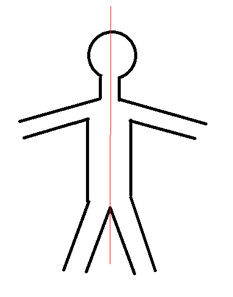This set of Clinical Science Interview Questions and Answers for Experienced people focuses on “Orthopaedics – Anatomical Terms & Numericals – Anatomical Terms of Motion”.
1. Complete the following relationship.
Anterior : Posterior :: Ventral : _________
a) dorsal
b) fin
c) central
d) extension
View Answer
Explanation: Anterior and ventral both stand for towards the front while the terms posterior and dorsal stand for towards the back. Central is simply meant towards the center of the body and extension is an action of straightening the body. Fin is a part of fish.
2. In medical terminology, what is the difference between Superior & Inferior and Cranial & Caudal?
a) No difference
b) Superior & Inferior is for large structures while Cranial & Caudal is for those in and around the brain and tail
c) Superior & inferior is used for humans while Cranial & Caudal is used for animals
d) Superior & Inferior is used for animals while Cranial & Caudal is used for plants
View Answer
Explanation: Cranial and Superior both mean towards the brain or towards the head. However, Caudal means towards the tail while Inferior both mean towards the legs. This distinction of terminology exists because animals have tails. While both the terminologies can be applied in case of humans (as they have a tail bone, i.e. caudal bone) but for animals, it is usually Cranial and Caudal only.
3. The antonym for ‘medial’ will be ___________
a) lateral
b) central
c) frontal
d) parallel
View Answer
Explanation: Medial is the term which says towards the center or the mid-line of the body while lateral mean away from the central or the mid-line of the body. Here, the body is referred can be the whole body or a part of the body. The terms are usually taken in the sagittal plane, i.e. the plane that divides the body in equal right and left parts.
4. Proximal stands for away from the root of the structure while distal stands for towards the root of the structure.
a) True
b) False
View Answer
Explanation: The sentences have been interchanged. Proximal is towards the root of the structure while distal is away from the root of the structure. For eg, the elbow joint is also called the Proximal Radioulnar Articular (or superior radioulnar joint) while the wrist joint is called the distal radioulnar articulation (or inferior radioulnar joint).
5. The term for ‘away from the surface’ is _____________
a) internal
b) external
c) superficial
d) deep
View Answer
Explanation: Deep means away from the surface while superficial means on the surface. Internal is a term used for inside the body while external means outside the body.
6. In the below diagram, the red line cuts the body in which section?

a) Sagittal
b) Coronal
c) Horizontal
d) Para Sagittal
View Answer
Explanation: The plane that cuts the body in equal right and left parts are called the sagittal section. The right and the left parts of the plane are called the para sagittal planes/sections of the body. If the body is cut in such a way that the superior and inferior parts are seen, it is a horizontal cut. If the body is sliced in such a way that the anterior and posterior parts are seen, then its the coronal plane.
7. In ‘flexion’ of the forearm, the humerus moves towards the radius and ulna. What movement will take the humerus away from the radius and ulna?
a) reflexion
b) deflection
c) extension
d) abduction
View Answer
Explanation: Flexion means the movement of bending while extension means the movement of straightening. When the body is flexed, it is bended, either towards (bones) or away (muscles) from the mid-line. When the body is extended, it gets straightened, i.e. it goes back to its original shape.
8. The antonym for ‘abduction’ will be ___________
a) adduction
b) reflexion
c) flexion
d) extension
View Answer
Explanation: Abduction is the movement that is towards the med-line while adduction is the movement that is away from the mid-line. When the arm is raised to shoulder level, the movement is adduction and when the arm is brought down, it is called abduction.
9. If the palm is facing downwards, then the movement that a person must do to make the palm face upwards is called as _________
a) abduction
b) adduction
c) pronation
d) supination
View Answer
Explanation: Prone means when the body is facing downwards while supine is when the body is facing upwards. Thus, if the palm is turned downwards, the movement is pronation and then the palm is brought upwards, the movement is supination.
10. The difference between rotation and circumduction is __________
a) rotation is any circular movement while circumduction is circular movement around something
b) rotation is the circular movement along the sagittal axis of the body while circumduction is the conical movement of the body around the sagittal axis of the body
c) circumduction is any circular movement while rotation is circular movement around something
d) circumduction is the circular movement along the sagittal axis of the body while rotation is the conical movement of the body around the sagittal axis of the body
View Answer
Explanation: As the answer says, a rotation is the circular movement along the sagittal axis of the body while circumduction is the conical movement of the body around the sagittal axis of the body. Thus, if there is pronation and supination of the palm, it will come under rotation but if shoulder rotation is done when the arm is fully extended, then its circumduction.
Sanfoundry Global Education & Learning Series – Clinical Science.
To practice all areas of Clinical Science for Interviews, here is complete set of 1000+ Multiple Choice Questions and Answers.
If you find a mistake in question / option / answer, kindly take a screenshot and email to [email protected]
- Apply for Biotechnology Internship
- Check Clinical Science Books
- Check Biotechnology Books
- Practice Biotechnology MCQs
